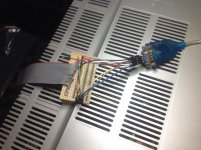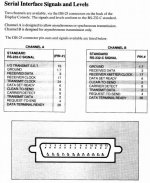JonB
Veteran Member
Hi
I'm using Lifeboat Associates CP/M 2.2 on the Model II and would like to transfer data over serial in a reliable fashion. Obviously I need hardware handshaking, and it is setup for that. I have a null modem cable connected between the PC and Model II and it does send and receive characters, but drops many of them. I'm using Hyperterm to test this.
On the Model II it is set for hardware handshaking, 8-N-1-9600.
In Hyperterm it is 8-N-1-9600 with flow control set to "Hardware".
I'm not 100% sure how my cable is wired, but it has NULL MODEM stamped on it. It has a DB9 female connector at one end and a DB25 female at the other end.
At the moment the only way to get reliable transfer is at 1200 baud, but where there is a large file to be transferred, chunks of it are lost whenever the Model II is writing to the disk.
In the Lifeboat Associates notes for this version, it says:
So it is using DTR to indicate readiness to receive, but what is it using DCD for? Confusing, badly worded... I thought it was RTS/CTS that was normally used for handshake. Anyone know?
Cheers
JonB
I'm using Lifeboat Associates CP/M 2.2 on the Model II and would like to transfer data over serial in a reliable fashion. Obviously I need hardware handshaking, and it is setup for that. I have a null modem cable connected between the PC and Model II and it does send and receive characters, but drops many of them. I'm using Hyperterm to test this.
On the Model II it is set for hardware handshaking, 8-N-1-9600.
In Hyperterm it is 8-N-1-9600 with flow control set to "Hardware".
I'm not 100% sure how my cable is wired, but it has NULL MODEM stamped on it. It has a DB9 female connector at one end and a DB25 female at the other end.
At the moment the only way to get reliable transfer is at 1200 baud, but where there is a large file to be transferred, chunks of it are lost whenever the Model II is writing to the disk.
In the Lifeboat Associates notes for this version, it says:
Hardware handshaking involves the computer monitoring two of the
connections to the DB-25S socket connectors on the TRS-80. The
receiver of a TRS-80 port is enabled with pin 8 (DCD) high, the
transmitter with pin 5 (RTS) high. The computer itself will
generate a high on pin 20 (DTR) when it is able to receive a
character, and so this can be used to control a device
transmitting to a TRS-80 port receiver.
So it is using DTR to indicate readiness to receive, but what is it using DCD for? Confusing, badly worded... I thought it was RTS/CTS that was normally used for handshake. Anyone know?
Cheers
JonB


